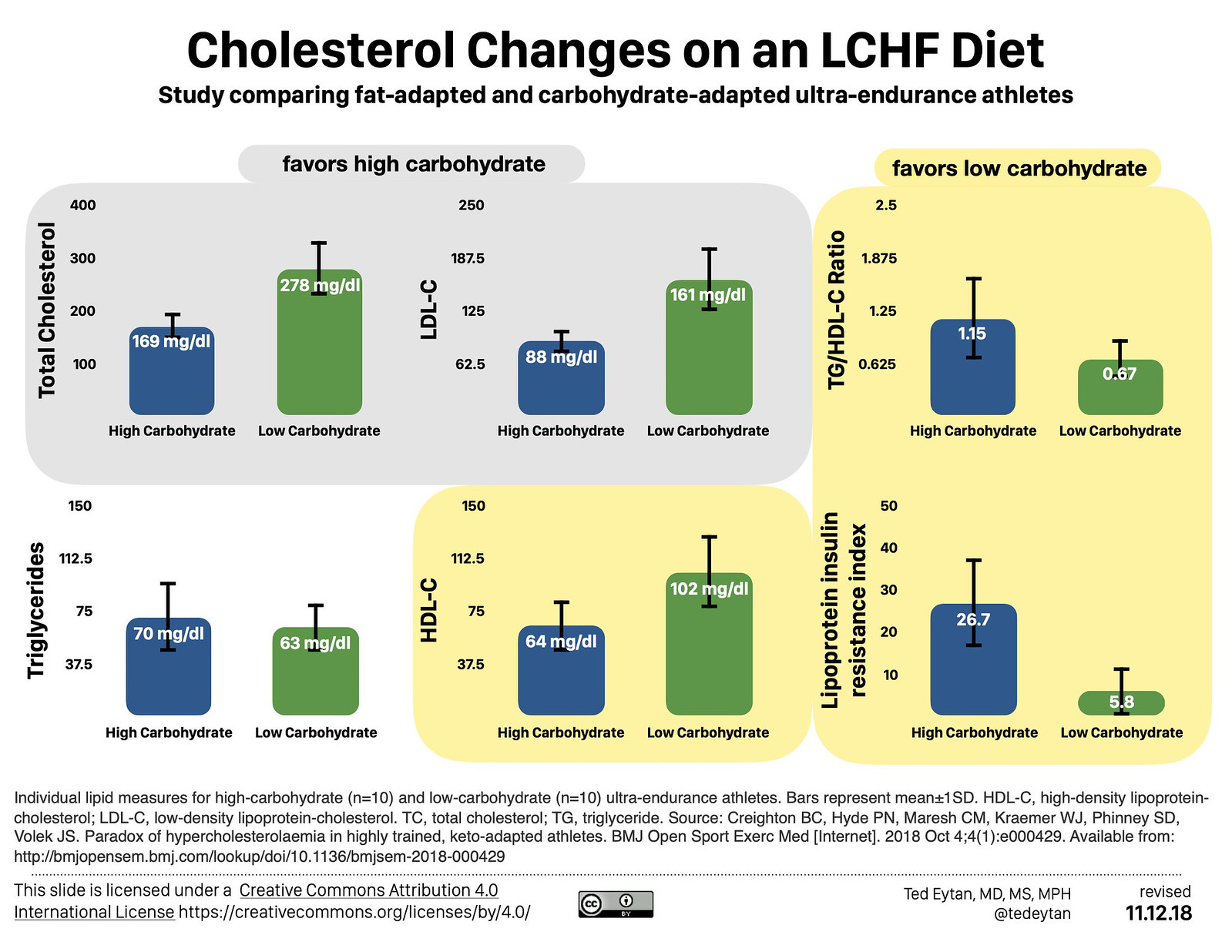
Noting also from the data above that while none of the athletes (high carbohydrate and low carbohydrate) met criteria for insulin resistance, markers of insulin sensitivity (TG/HDL-C ratio and Lipoprotein insulin resistance index) were significantly better in the low carbohydrate group.
“Ketogenic diets in normal-weight and overweight non-athletes result in a moderate increase in total, LDL-C and HDL-C concentrations relative to low-fat diets. The observation that highly trained, ultra-endurance athletes consuming a very low-carbohydrate/high-fat diet exhibited a more dramatic and uniform hypercholesterolaemia is counterintuitive since high-volume exercise tends to lower total and LDL-C levels. The explanation for this paradox may involve high intake of cholesterol and saturated fat combined with high-energy demands for lipid metabolism characteristic of the keto-adapted phenotype. LC athletes who adopt a ketogenic diet may experience an expansion of their endogenous cholesterol pool during the adaptation phase of the diet, after which they maintain greater circulating cholesterol levels.”
Individual lipid measures for high-carbohydrate (n=10) and low-carbohydrate (n=10) ultra-endurance athletes. Bars represent mean±1SD. HDL-C, high-density lipoprotein-cholesterol; LDL-C, low-density lipoprotein-cholesterol. TC, total cholesterol; TG, triglyceride. Source; Creighton BC, Hyde PN, Maresh CM, Kraemer WJ, Phinney SD, Volek JS. Paradox of hypercholesterolaemia in highly trained, keto-adapted athletes. BMJ Open Sport Exerc Med [Internet]. 2018 Oct 4;4(1):e000429. Available from: bmjopensem.bmj.com/lookup/doi/10.1136/bmjsem-2018-000429 – Re-use permitted under CC BY-NC.
This is a very helpful study which establishes via a good protocol that people on low-carbohydrate diets can experience a significant rise in their cholesterol levels. Across a population, there may not be a significant rise of LDL cholesterol on average. However, at the individual level, there may be changes that significantly concern patients and their physicians used to treating based on a single number (LDL cholesterol). This issue has been well-described in the social media community and at many conferences, not documented as well in the peer-reviewed literature.
This study looks at the broader lipid picture in 20 ultra-endurance athletes, some on a high-carbohydrate diet, some on a low-carbohydrate diet (one size does not fit all, even among athletes). What’s good about it is the technique for acquiring the data was carefully adhered to. It’s known that when and how you acquire samples for lipid measurements can dramatically change the results.
Differences in cholesterol are present
As the image above shows, there are significant differences in groups of athletes in their
- Total Cholesterol (favorable* in the high carbohydrate group)
- LDL Cholesterol (favorable* in the high carbohydrate group)
- Triglycerides (about the same in both groups)
- HDL Cholesterol (favorable in the low carbohydrate group)
- Measures of insulin resistance (favorable in the low carbohydrate group)
*Its not really clear that these measures are “favorable” if the lower LDL is the result of an insulin resistant state, read below on health impact
These all track what has been observed previously, although the authors stated that they expected there to be less differences given the athletic activity of the subjects.
The mechanism for the differences is unclear
In addition to acquiring the data above, the authors also acquired measures of cholesterol metabolism not normally measured in humans, including measures of production and absorption. There, they found evidence of a steady state in the low-carbohydrate group, with an overall higher “pool” of circulating particles, possibly to feed a greater reliance of the body’s cells on fat:
The fact that the overall ratio of cholesterol synthesis to absorption markers (ie, the fractional cholesterol balance) was the same between LC and HC athletes is consistent with the fact that greater consumption of cholesterol by LC athletes is trans- lated into an expansion of their circulating cholesterol pool.Creighton BC, Hyde PN, Maresh CM, Kraemer WJ, Phinney SD, Volek JS. Paradox of hypercholesterolaemia in highly trained, keto-adapted athletes. BMJ Open Sport Exerc Med [Internet]. 2018 Oct 4;4(1):e000429.
The impact on health is unclear
The study is cross sectional and did not look at long term health impacts of this situation. What can be observed is the presence of differences that would be considered beneficial for health (improved insulin sensitivity, HDL cholesterol levels, size and nature of LDL particles) and some that would “not be” (increased measured LDL cholesterol).
The challenge of saying whether the higher LDL is good or bad is because of the many different ways LDL particles are regulated in the body. They may be necessarily elevated to deliver energy or help the body repair itself. They may be lowered in the presence of insulin resistance (not a good thing).
New cholesterol guidelines have just come out (November 10) which may help patients and physicians understand risks better than previous recommendations allowed them to. I’ll post on that later.
In the meantime, this study provides some understanding/guidance of what may happen as people pursue therapeutic nutritional approaches to reversing or preventing diabetes.
This doesn’t happen to every person
Reminder that not every patient experiences these changes.
See this example from @MightyCasey: Yes she did lose 30 pounds and reverse her prediabetes with an LCHF diet – My second appearance on the Healthcare is HILARIOUS Podcast: Keto me to end pre-diabetes? Why YES PLEASE
There are several talented physicians, engineers, and citizen scientists in this space, including Jeffry Gerber (@JeffryGerberMD), Ivor Cummins (@FatEmperor), Dave Feldman (@DaveKeto), and Siobhan Huggins (@Siobhan_Huggins) who are narrowing down differences based on body type (Lean mass, vs non-lean mass) and other factors, in ways the medical profession is only beginning to understand.
Discuss with your personal physician
I’ve just put up a separate disclaimers page so I don’t have to repeat myself on every post. Suffice to say, a study like this cannot be used to provide medical guidance. A person’s whole health picture must be reviewed with a professional.
1 Comment
So many great reads on this blog site. Much appreciated. I follow Dr Esselstyn,, but am always in search of more wisdom and your site is helpful